Demonstrate: How to deploy Red Hat OpenShift to an IBM Cloud Satellite Location
Demonstrating how to provision an IBM Cloud Satellite enabled service may be of interest to some audiences, but this activity is typically done only a couple of times by a client and is usually performed by their technical team. This demonstration does not illustrate the real business value of IBM Cloud Satellite. It is included in this asset for completeness. If you have limited time to perform a live demonstration, you may want to briefly cover this process and move on to some of the other demonstrations described in later parts of the demonstration script.
There are several approaches you can take in doing an actual demonstration of the provisioning process of a Satellite enabled IBM Cloud service.
- Play the video in the previous chapter to the client. It includes both narration and annotations.
- Use the raw video (below) from the previous chapter and provide your own narration to the video. You will want to pause the video at appropriate locations based upon your narration and any questions your client may have.
Info
This video has no sound and is intended to be played while you narrate. Also, the IBM Cloud portal and the IBM Cloud Satellite product changes regularly. You may notice some differences between the video and the actual user interface and experience you see today.
Note: If the video appears blurry, click the fullscreen  or
or  icon.
icon.
- Alternatively, you could also do this demonstration using the IBM Cloud portal up to the point of clicking the "Create" button. Then switch to the already provisioned cluster and describe what took place during the provisioning process. This "baking show" approach shows all the steps, but avoids the delays that would be required to perform the provisioning of resources.
The steps below can be used as a guide for this style of demonstration:
- Launch the IBM Cloud portal to the Satellite enabled catalog page: https://cloud.ibm.com/catalog?search=label%3Asatellite_enabled.
Tip
The IBM Cloud Portal will be opened in a new browser tab. You need to switch between this tab and the new tab to accomplish many of the tasks. You may want to open the new tab in a new window and display both browser windows at the same time. You may need to disable pop-up blockers if you do not see the new tab. Also, Firefox and Safari browsers are recommended as the image quality of screen captures when viewed in Chrome are sub-optimum.
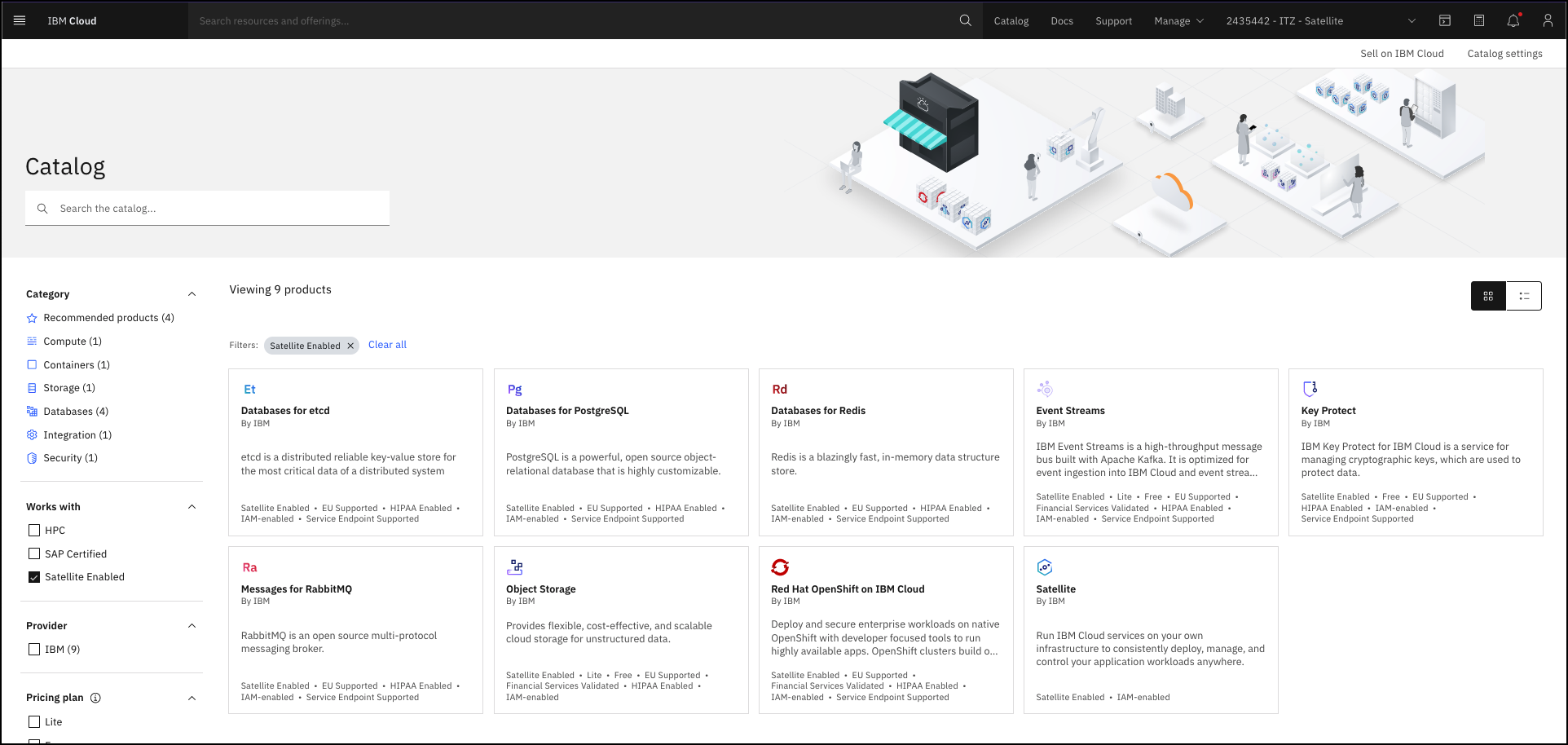
Sample dialog: The current catalog for IBM Cloud Satellite enabled services include IBM Cloud Databases like etcd, PostgreSQL, Redis, and RabbitMQ. In addition, IBM Event Streams is available and provides a high-throughput message bus with Apache Kafka. There is also IBM Key Protect for IBM Cloud for managing cryptographic keys for data protection. And we also support Red Hat OpenShift on IBM Cloud as well as Cloud Object Storage.
- If you haven't already, change from your IBM Cloud account to the demonstration IBM Cloud account: 2435442 - ITZ - Satellite*.
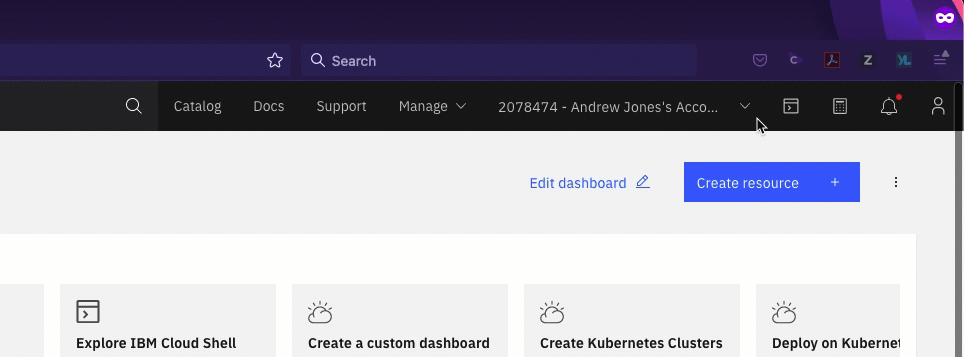
Tip
If your browser window is narrow, you may see this icon: ![]() instead of the current account name as shown in the screen capture above.
instead of the current account name as shown in the screen capture above.
- Click the Red Hat OpenShift on IBM Cloud tile.

Sample dialog: For this demonstration, I'll show you how simple it is to deploy these Satellite enabled services. Red Hat OpenShift on IBM Cloud provides a managed container platform for running enterprise workloads in Kubernetes clusters. With OpenShift on IBM Cloud, you only need to focus on your applications and IBM will manage the platform.
- Select the Satellite tile under the Infrastructure section.
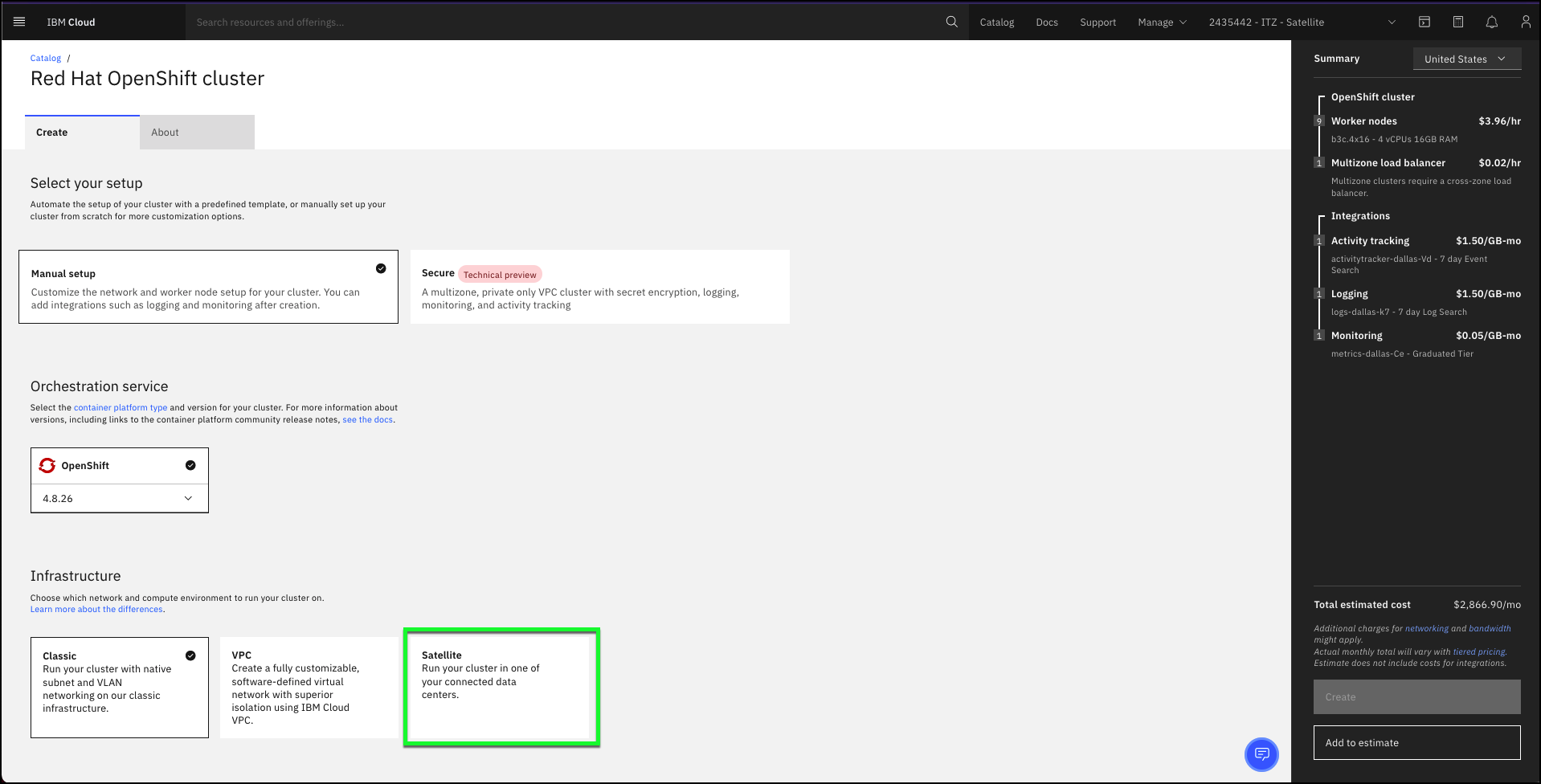
Sample dialog: Red Hat OpenShift on IBM Cloud is support in the IBM Cloud classic and Virtual Private Cloud (VPC) environments, as well as Satellite.
- In the Location section, select the aws-us-east-2 location in the table.
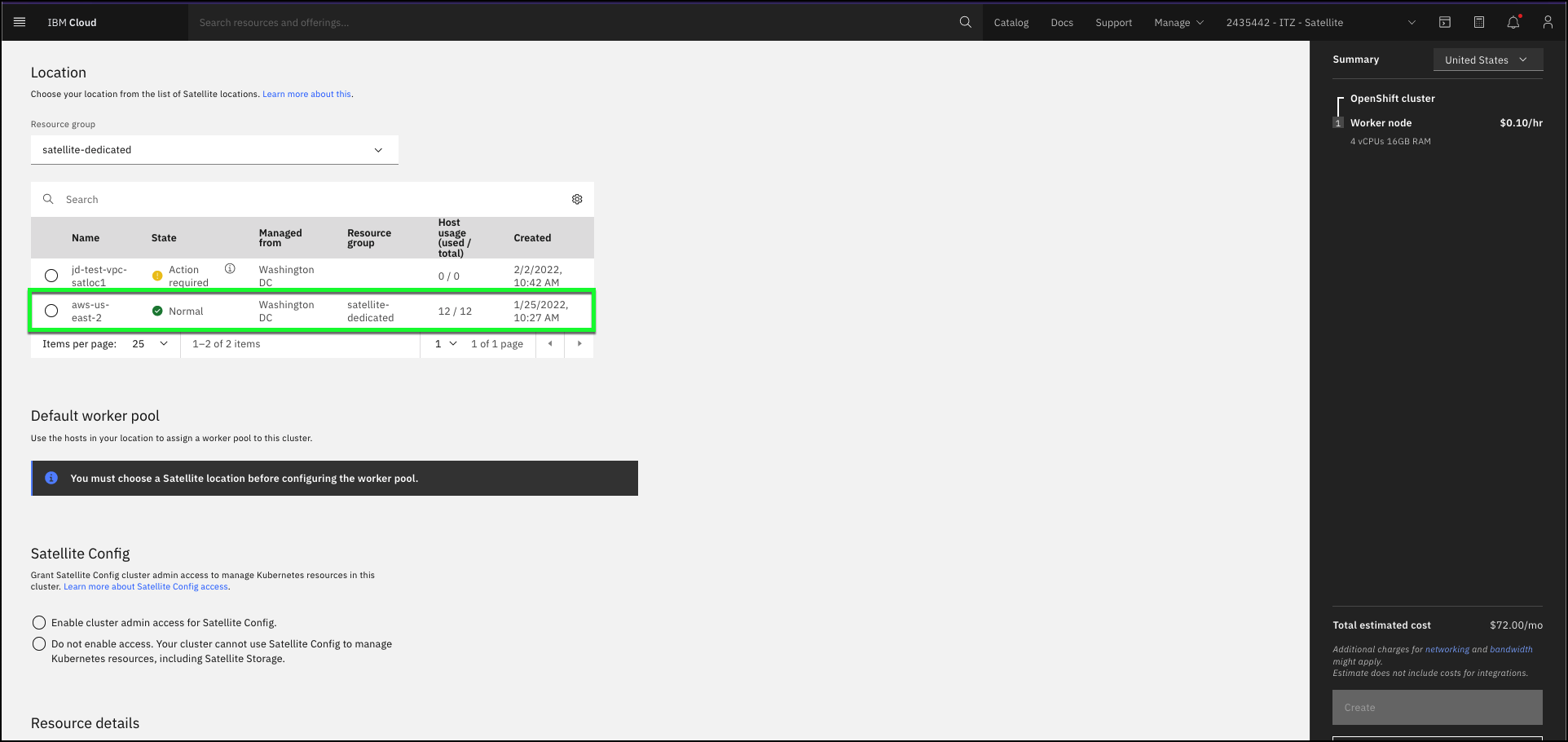
Sample dialog: Once I select Satellite, I just need to specify the IBM Cloud Satellite location where I want to deploy OpenShift. As a prerequisite, the Satellite Location will need hosts available for the deployment to succeed. As you will recall, when we created our Satellite Location, we provisioned 3 hosts for the control plane, and 9 hosts as worker nodes. I'll use those 9 hosts as my OpenShift worker nodes, place 3 in each of the 3 availability zones in our Satellite Location.
- Change cluster name to aws_os_cluster.
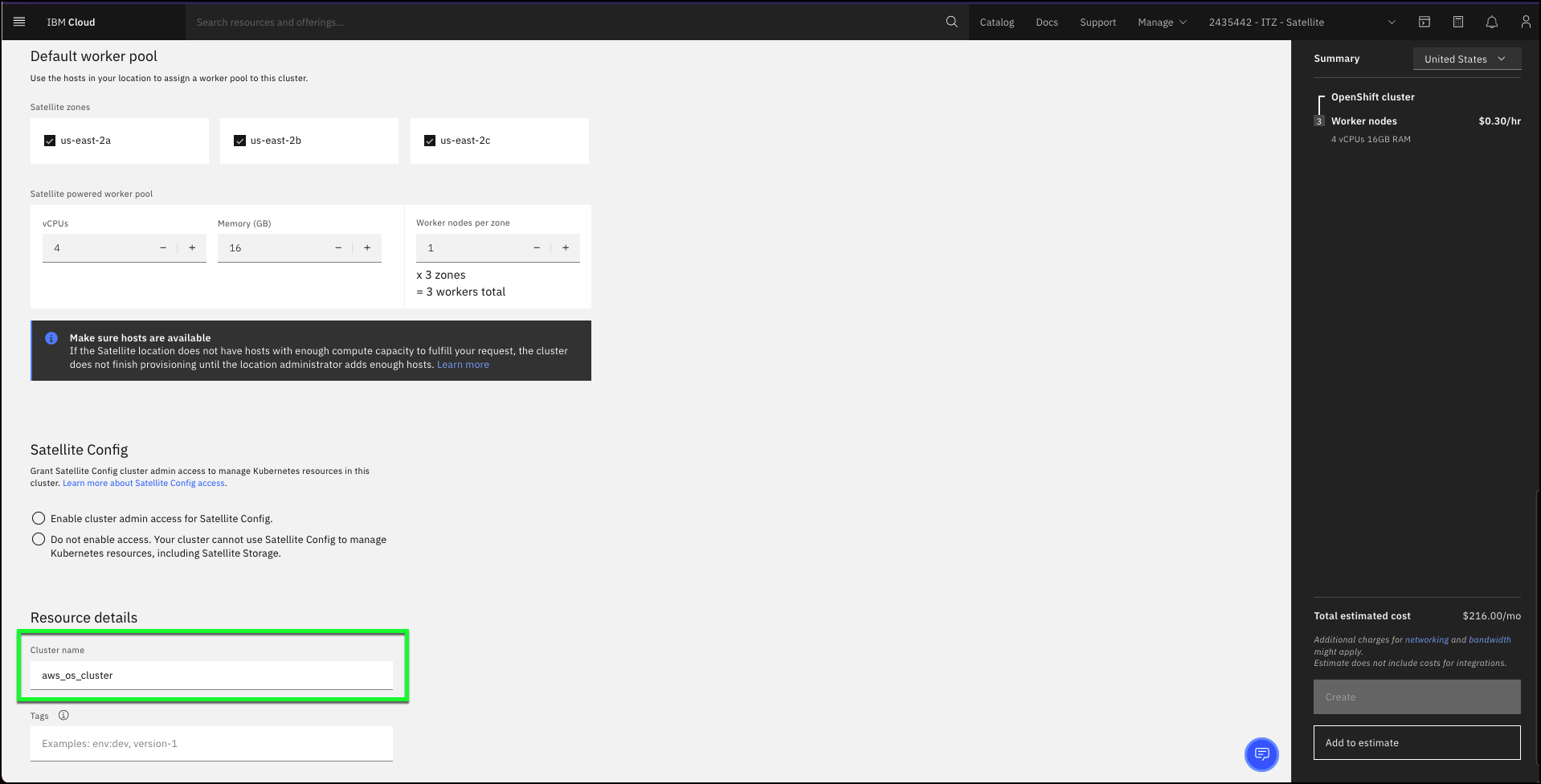
Important
Once you specify a name, the Create button at the far right of the portal would typically be enabled. Since you do not have the appropriate permissions in this account to create a new cluster, the button remains disabled. Now is the time to explain what happens if you were to click create.
Sample dialog: That is all the information that is required. Now just click create and let the automated provisioning begin. When I originally provisioned the OpenShift environment in the AWS Satellite Location, it took about 50 minutes for the entire installation and configuration of the OpenShift cluster. Let us now look at an already provisioned cluster in our Satellite location.
- Click the
 menu and select Satellite->Clusters.
menu and select Satellite->Clusters.

- Click aws_os_cluster in the Clusters table.

Sample dialog: Here you see the cluster we provisioned and the cluster's current status.
- Time to wrap up this part of the demonstration.

Sample dialog: We can retrieve the details of the cluster and manage it using the IBM Cloud portal as well as the OpenShift web console. From a Red Hat OpenShift on IBM Cloud perspective, this cluster is just like any other Red Hat OpenShift on IBM Cloud cluster running in IBM Cloud.